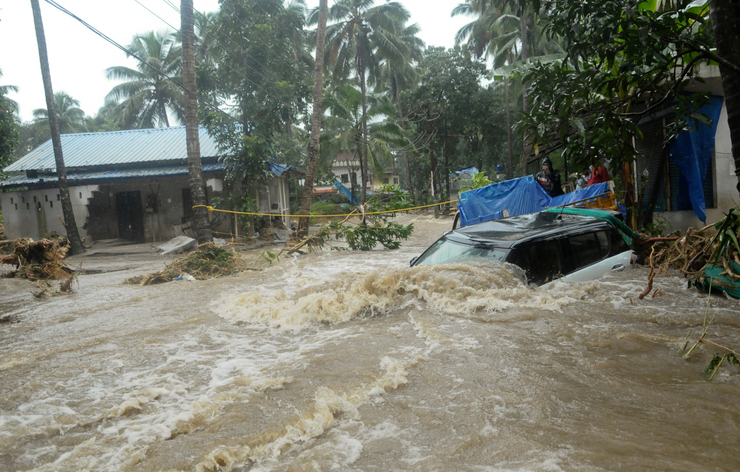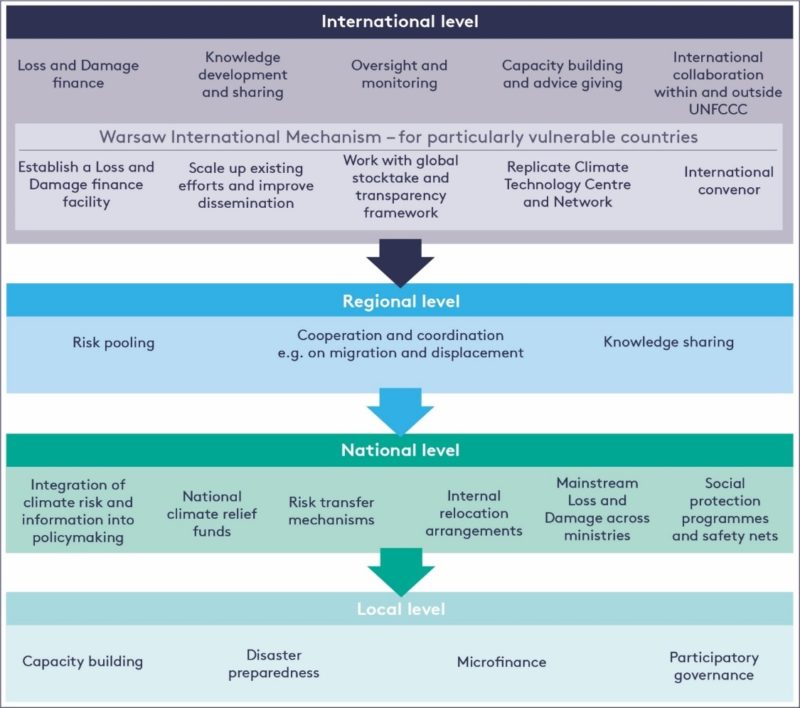What is climate change ‘Loss and Damage’?

The distinction between loss and damage from climate change and the ‘Loss and Damage’ policy debate
Loss and damage refer to the negative consequences of climate change on human societies and the natural environment. Climate change is affecting the frequency, intensity and geographical distribution of extreme weather events such as storms, floods and heatwaves, and slow-onset events such as sea level rise, ocean acidification, loss of biodiversity and desertification. All of these result in loss and damage, both economic and non-economic. Economic loss and damage may include damage to crops, homes or infrastructure. Non-economic loss and damage may include harm to human health and mobility; loss of access to territory, of cultural heritage and of indigenous and local knowledge; and loss of and damage to biodiversity and habitats.
‘Loss and Damage’ has a distinct but contested meaning in the international climate change policy debate. It is predominately about how to support developing countries that are particularly vulnerable to the adverse effects of climate change. This is explained further below.
How is climate change causing loss and damage?
The impacts from extreme weather events and slow-onset events that are harming human societies and infrastructure and the natural environment arise through a combination of both anthropogenic (human-caused) climate change and natural climate variability. The scientific consensus is that human-caused climate change increases the frequency and severity of climate-related events overall and can also compound the effects of natural climate variability, such as El Niño-Southern Oscillation (ENSO) cycles. These factors are leading to more destructive climate impacts and higher risks of loss and damage. Attributing specific losses and damage to human-caused climate change is a challenge, although ‘attribution science’ is a fast-growing research field. A better understanding of the extent to which loss and damage are attributable to climate change can provide a stronger evidence base for decision-makers to implement policies and actions to avert, minimise and address loss and damage.
The extent of loss and damage
Some loss and damage from climate change are unavoidable. This is for two reasons. Firstly, some climate change impacts are inevitable as they are already ‘locked in’ to the Earth’s system due to the extended period over which emitted greenhouse gases fully affect the climate system. Secondly, there are limits to how far we can adapt to climate change impacts. Loss and damage may occur where adaptation has not been optimally implemented or where adaptation limits are reached – because actions are unaffordable, not physically or technically possible, socially difficult or simply not sufficient to prevent some harm to humans, the environment and assets.
As an example of the financial cost of damage caused by extreme weather events linked to climate change, the extreme flooding in Pakistan in 2022 is estimated to have caused losses costing up to US$40 billion dollars. Climate change exacerbated the flooding by increasing the intensity of rainfall by an estimated 50 to 75%. The floods affected 33 million people, cost 1,600 lives, destroyed over 2 million houses, and damaged 13,000km of roads and 18,000km2 of cropland with crop losses estimated at US$2.3 billion.
Depending on the extent of global efforts to mitigate and adapt to climate change, loss and damage from climate change that go beyond adaptation could cost developing countries a total of US$290–580 billion in 2030 and reach US$1–1.8 trillion in 2050.
Loss and Damage in the international climate negotiations
Loss and Damage in the international policy debate broadly refers to efforts to “avert, minimise and address loss and damage associated with climate change impacts, especially in developing countries that are particularly vulnerable to the adverse effects of climate change” (UNFCCC Decision 3/CP.18). Generally, the terms ‘avert’ and ‘minimise’ are used to refer to mitigation and adaptation respectively, whereas the term ‘address’ refers to actions to deal with climate change impacts that have not been or cannot be avoided.
The Loss and Damage debate has been contentious within the international climate negotiations because of questions of fairness and equity, and proving historical responsibility for climate change. Developing countries claim that developed countries have historical responsibility for climate change. As such, they have called for compensation from developed countries to help them address loss and damage that have already occurred and to minimise future loss and damage. However, calls to pay compensation have been a major red line for many of these wealthy nations, which consider addressing Loss and Damage as ex-ante adaptation, namely advance measures to minimise loss and damage. In focusing on minimising future harm, developed countries have sought to treat Loss and Damage as a sub-component of adaptation within the UNFCCC negotiations. This is addressed through the Warsaw International Mechanism for Loss and Damage, established at the COP19 UN climate conference in 2013. The role of the Mechanism is to address the issue of loss and damage in developing countries by enhancing knowledge of risk management approaches, strengthening coordination to address losses and damage, and increasing action and support, including finance, technology and capacity-building (the need for which is recognised in Article 8 of the Paris Agreement).
During the review of the Mechanism in 2019 at COP25, many developing countries called for its role to be strengthened and for it to deliver finance to vulnerable, developing countries to minimise and address loss and damage. However, consensus was not reached on developed countries’ obligation to finance loss and damage. In 2021, at COP26, further debate on Loss and Damage finance culminated in the establishment of the Glasgow Dialogue on Finance for Loss and Damage.
A milestone for loss and damage was reached in 2022 at COP27 in Sharm El Sheikh, where Parties agreed to establish a dedicated ‘Loss and Damage Fund’. A transitional committee was formed to work on the mechanisms of the fund, including who will host it, who pays, and who benefits. Agreement on the operationalisation of the fund was secured on the first day of COP28 in the UAE.
Reducing loss and damage from climate change
Ways to reduce loss and damage from climate change include increasing resilience before the occurrence of an extreme weather or slow-onset event – for example, by strengthening flood defences – and establishing mechanisms to provide financial or social protection support to those who have already experienced loss and damage. Insurance is one important tool but is not affordable or accessible to all. There are also opportunities to reduce loss and damage after extreme weather events by incorporating resilience into recovery, such as rebuilding infrastructure to be more climate-resilient in the future.
Specific actions to mitigate and adapt to climate change are essential in both developing and developed countries, to avert and minimise the extent of loss and damage they experience. But broader policy and governance arrangements also play a significant role. This is because communities’ vulnerability and exposure to climate change is influenced by a multitude of factors, such as land-use planning, access to education and health services, quality and location of infrastructure, and disaster preparedness, to name but a few, which requires a response across different policy areas. Key to this is pursuing the “role of sustainable development in reducing the risk of loss and damage” (Article 8 of the Paris Agreement). This involves targeting the most vulnerable communities and developing policies that address the root causes of their vulnerability, to build resilience against future loss and damage.
The figure below shows example actions that can help minimise and address loss and damage at different geographical scales.

Source: Byrnes and Surminski (2019)
This explainer draws on ‘Addressing the impacts of climate change through an effective Warsaw International Mechanism on Loss and Damage’ by Rebecca Byrnes and Swenja Surminski, published by the Grantham Research Institute in 2019, and was updated by Adeline Stuart-Watt in October 2022. For a comprehensive overview of Loss and Damage also see ‘Loss and Damage from Climate Change: Concepts, Methods and Policy Options’ (Springer, 2019; open access), co-edited by the Institute’s Head of Adaptation Research, Swenja Surminski.

